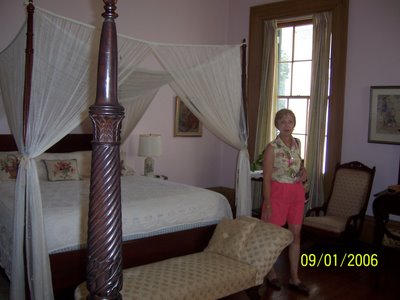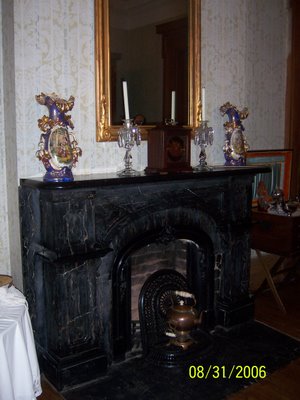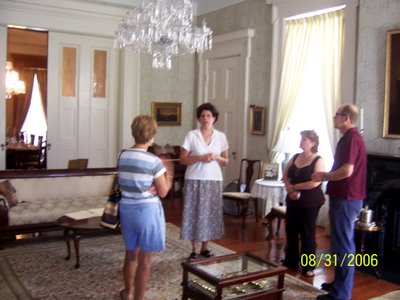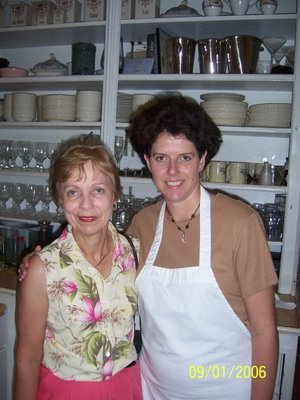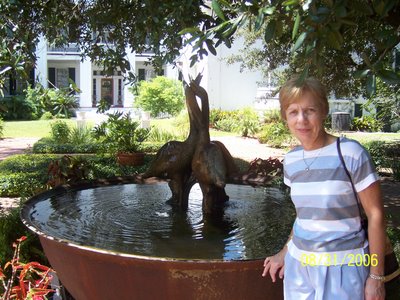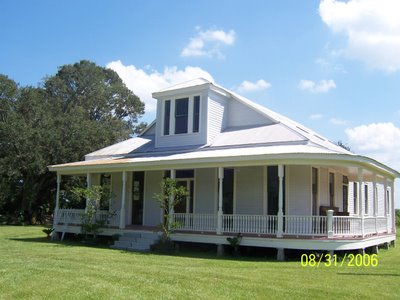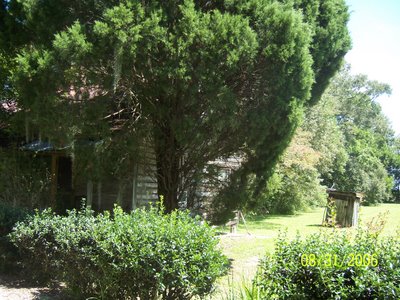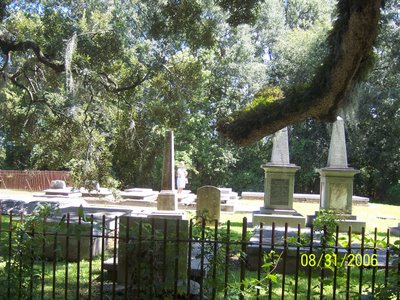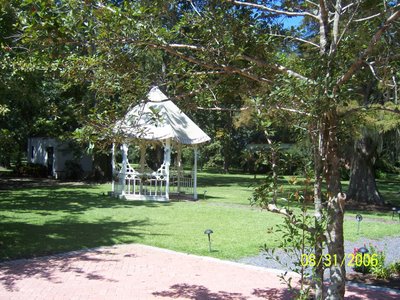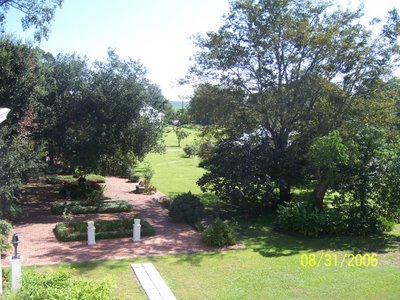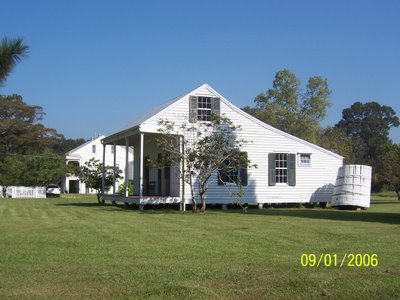Saturday, September 09, 2006
A video link from my friend Les who is back from his holiday

He sent me this link to a "Senior Video."
Date: Fri 8 Sep 10:37:12 CDT 2006
From: "Les
Subject: Fw: Senior Citizens
To: A whole bunch of us
You are bound to love this one...And, if you are not a Senior, you‘d wish that you were one. Speakers on!!!!!!!!!!!! I love the piano on this one.
Seniors Humor Video Life Friends
Enjoy. Click here: Seniors
Friday, September 08, 2006
Eight Elegant Beauties
First there are three white long stemmed roses.
Those three are followed by three red long stemmed roses.
It can't get much better than that.
Thursday, September 07, 2006
What's the difference between a bayou and a river?
[Click on pictures to enlarge]
.
This is Bayou Lafourche (prounounced la-foosh) near Napoleonville, Louisiana. It starts at Donaldsonville and runs down to the Gulf of Mexico.
Originally some of the Mississippi River water was diverted into the bayou. A dam was built in 1905 cutting off its major water supply. Without that it becomes the lazy little stream you see here. (link to Bayou Lafourche)
A lot of these bayous have homes, large and small, alongside. Most of these homes have small boats or pirogues (link) (pronounced pee-row) tied to a side dock. We didn't see any of these where we were.
Good-bye Joe, me gotta go, me oh my oh
Me gotta go pole the pirogue down the bayou
My Yvonne, the sweetest one, me oh my oh
Son of a gun, we’ll have big fun on the bayou
[Hank William's Jambalaya song-link]
.
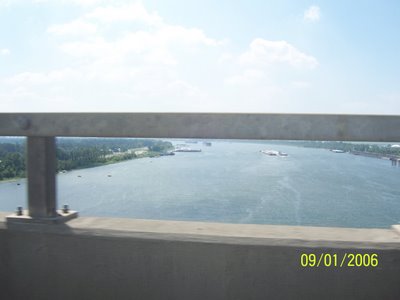
.
This is the Mississippi River, the longest river in the U.S.
.
It starts in Minnesota at Lake Itasca (link to Wikipedia discussion) and ends also in the Gulf of Mexico.
[Picture--Image:Lake Itasca Mississippi Source.jpg--courtessy of the Wikimedia Commons.]
.
.
Mrs. Jim knows the difference between a bayou and a river. You can too. See these: (Bayou link) and (River link).
The largest bayou may be the Houston Ship Channel, which is the lower end of Buffalo Bayou (link), dredged out.
Houston's is often called the Bayou City because of its many bayous.
. Bayou Houston+Ship+Channel Photos Louisiana Life Boats Rivers travel+and+places Travel
[So called "primarily because of the massive, muddy, miles-long Buffalo Bayou that twists and turns its way through the fourth largest city in the United States. Other major bayous in Houston include Brays Bayou, Sims Bayou, White Oak Bayou, and Greens Bayou." Wikipedia, Bayou]
Wednesday, September 06, 2006
Don't tell HomeLand Security, but Alpha III Rocket Launch Is Successful Right Here!
Up, Up, and Away!
Don't tell HomeLand Security, but my nine-year-old granddaughter is building and launching rockets.
Watch her successful launch while her friend watches, covering his ears.
Oh yes, recovery was very successful too!
See and link to or bookmark this video directly from YouTube. (click here)
.
Science Life Family hobbies
Rocket Rockets YouTube
Tuesday, September 05, 2006
Madewood Plantation, our South Louisiana summer break. Part II, the Mansion
This is Madewood Plantation House. It was a mansion made to order for the Pugh family, and was finished in 1952. Before it was finished, Mr. Pugh died.
Now it is a very fine bed and breakfast hotel. This was started in the 1980s to help pay some utility bills, a lot of electricity is used to have comfortable air conditioning in the warm, muggy summers.
Our room was upstairs, behind those two windows on the right. It is the master bedroom.
.
Materials from the land were mostly a lot of cypress trees. That wood is very hard. Bayou Lafourche is on the other side of the road, behind me when I was taking the front view of the house picture.
.
 .
.
Knock three times and say "sent by Joe." Seriously, there was a button there to ring. That wasn't necessary because we were greeted, almost as soon as we got out of the car, by Jessica.
.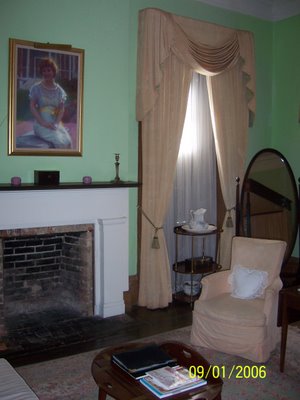 .
.
The next three pictures were of our bedroom. Shown here is the south wall.
The mantel for the fireplace is made of cypress wood, as are the other fireplace mantels. Even the fine doors are made from cypress wood.
.
 .
.
Clockwise, skipping the west wall with the two large walkout windows leading to the balcony, is the canopy bed, against the north wall. Notice its height. Some of the bedrooms have step stools for getting into bed.
.
 .
.
Skipping again, this time the bathroom on the east, further clockwise is back to fireplace where Mrs. Jim was catching up on her e-mail.
.
Behind Mrs. Jim is one of the walkout windows from the bedroom. Its shutters were shut to help keep out the heat from the afternoon sun.
.
I was standing at the south end of our balcony.
.
Mrs. Jim was impressed with those columns. They too are made of cypress wood from the plantation running as one piece, from the ground up to the ceiling of the balcony.
.
The other front bedroom is on the north end, also opening to the balcony. Between that and our master bedroom is the former sitting room opening to the master bedroom. It is now used as an adjoining bedroom to the master bedroom.
.
Here is another bedroom at the back of the house. They have access to the back porch balcony, but do not open directly onto it.
.
The table in the dining room was set for company. And for our breakfast, on this end.
.
The entrance hallway runs from the front door to the back. We are looking at the back door.
Angie was giving us a tour of the house. We were beginning along with the other visiting couple. They were from Tennessee.
.
This fireplace's mantel with intricate carving is also from cypress wood.
.
The sitting room opens through sliding doors to dining room. It is 30 by 26 feet in size.
.
This is the old kitchen, restored to museum quality. Note the Clementine Hunter pictures above the fireplace.
I didn't get pictures of the parlor or the library, or some of the other bedrooms. It is all so nice.
None of the furniture is original to the house. But the second and third--present--owners purchased furnishings to match the original period.
.
Angie was also our cook on the second morning. Angie wears many hats, on weekends she gives the house tours. During the week she helps run the place as needed. Plantation travel+and+places Food+and+Drink Travel Food Louisiana Photos Reviews
.
[Click on any picture to enlarge it. Then do an 'F 11' to make it full screen. Another 'F 11' brings it back to normal display, the back button returns to the posted blog material]
[Click here for Part I if you want to see the rest of Madewood]
Monday, September 04, 2006
Successful Launch of Alpha III
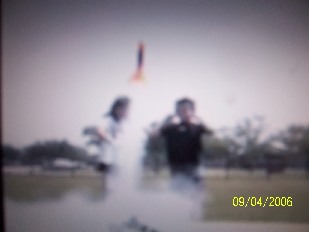
GC#4 and her neighbor are shown here launching GC#4's model rocket that she dubbed Alpha III.
The launch was very successful. Note her friend was holding his ears in case it was LOUD.
.
.
A successful Recovery Too!!
.
.
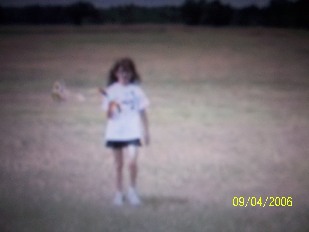
That was after a very high flight. The parachute landing was about three hundred feet away.
Rocket Family Rocket+Launch Life
Maybe I'll get invited for that next launch.
Madewood Plantation, our South Louisiana summer break. Part I, the grounds
Madewood has become a very nice bed and breakfast place to stay. Located at Napoleonville, Louisiana (click here for map and driving directions), it is forty-five minutes from Baton Rouge and a little over an hour and a half from New Orleans.
Today's blog posting will be a tour of the grounds of the plantation. Tomorrow should be a tour of the mansion.
Above we see the plantation mansion. Our room was the master bedroom, the first two walkout windows upstairs on the right show where we stayed.
.
The center piece of this lovely garden is a sugar kettle from the original sugar mill on the premises.
.
This building was a nearby blacksmith's home that has been saved from demolition and is now restored.
.
A slave home was also moved here from a nearby plantation. It is presently being used as a residence. Don't worry about that outhouse, it now has indoor plumbing and air conditioning.
.
The family cemetery is at the back of the farm place. The most recent burial we could find was in 1948.
.
We left Friday morning. Saturday there will be a big wedding here. Nuptials will be exchanged in the gazebo. Gazebos are a Southern fixture, we don't have ours yet.
.
The brick path leads from the back porch to that nice little garden with the sugar kettle. You can see some of the out buildings in the background.
.
We found this plantation home at the rear of the property, the first greeting coming, it tells us goodbye on leaving. The rainbarrel here is not being used, others still are.
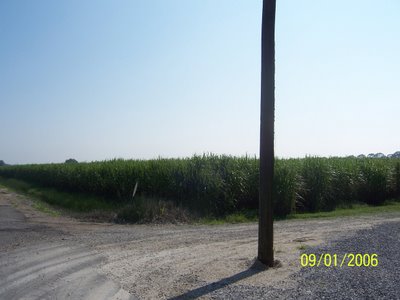
Plantation travel+and+places Food+and+Drink Travel Food Louisiana Photos Reviews
Sugar cane is the cash crop for the plantation's over 2000 acres of Mississippi River bottom land. The crops look good down here this year. [The rest of the state was not so fortunate.]
[Click here for Part II if you want to see the rest of Madewood]
Sunday, September 03, 2006
. . . On The Isle of Capri . . .
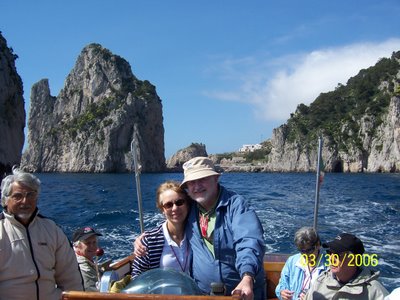
.
New International Version (NIV)
Copyright © 1973, 1978, 1984
Capri Travel Love Religion+and+Philosophy Italy







